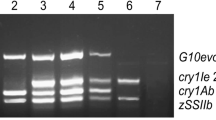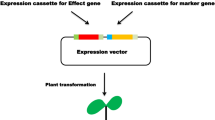Abstract
The hybridization method, also used for stacking multiple transgenes, has been performed by the plant breeders since the beginning of the genetic improvement of the cultivated species. In spite of the absence of evidence of effects caused by the gene stacking by hybridization in transgenic plants, additional studies have been required by the Regulatory Agencies as a condition for the approval of the stacked product. The objective of this work is to demonstrate, through the comparison of the nutritional composition, the phenotypic traits and the expression of the transgenic proteins CRY1F, CRY34AB1, CRY35AB1 and PAT, that the plant carrying multiple transgenes stacked by hybridization is equivalent to the isogenic hybrid and to the parents carrying the single events. In this work, in order to demonstrate the nutritional and phenotypic equivalence, the stacked corn TC1507 × DAS-59122-7 was compared with the isogenic hybrid. Grains and forage were tested for nutritional composition (protein, carbohydrates, ash, fiber, minerals, amino acids, fatty acids, vitamins and antinutrients). The plants were compared for their phenotypic traits (vigor, time of flowering, plant height, ear height, lodging and productivity). The expression of the transgenic proteins (CRY1F, CRY34AB1, CRY35AB1 and PAT) by the stacked product was compared with the expression by the plants carrying the single events TC1507 and DAS-59122-7. The conclusion of this work is that the plant carrying the stacked transgenes is equivalent to the plants carrying the single events, confirming the absence of any effect caused by stacking genes through hybridization in transgenic plants.
Similar content being viewed by others
References
Aumaitre A, Aulrich K, Chesson A, Flachowsky G, Piva G (2002) New feeds from genetically modified plants: substantial equivalence, nutritional equivalence, digestibility, and safety for animals and the food chain. Livest Prod Sci 74:223–238
Clark JH, Ipharraguerre IR (2001) Livestock performance: feeding biotech crops. J Dairy Sci 84:E9–E18
Cromwell GL, Lindemann MD, Randolph JH, Stanisieweski EP, Hartnell GF (2001) Soybean meal from Roundup Ready or conventional soybeans in diets for growing-finishing pigs. J Anim Sci 79:1318
Faust M (2000) Livestock products composition and detection of transgenic DNA/proteins. In: Proceeding of annual meeting ADAS-ASAS agricultural and biotechnology market. Baltimore MD, USA, pp 1–48
International Life Sciences Institute (2010) ILSI Crop Composition Database: version 4.0. www.cropcomposition.org. Accessed 10 Dec 2013
Lyons DE, Thomas AD (2010) Determination of phosphinothricin acetyltransferase (PAT) protein in maize tissues by enzyme-linked immunosorbent assay, 2010, GRM 07.25, unpublished method of Dow AgroSciences LLC
Magalhães PC, Durães FO (2006) Fisiologia da produção do milho. Embrapa, Sete Lagoas
Organization for Economic Co-operation and Development (2014) Consensus document on compositional considerations for new varieties of maize (Zea mays): key food & feed nutrients, antinutrients & secondary plant metabolites. http://www.oecd.org/science/biotrack/46815196.pdf. Accessed 15 Jan 2014
Padgette SR, Biest Taylor N, Nida DL, Bailey MR, MacDonald J, Holden LR, Fuchs RL (1996) The composition of glyphosate-tolerant soybean seeds is equivalent to that of conventional soybean. J Nutr 126:702–716
Ramalho MP et al (2012) Aplicações da genética quantitativa no melhoramento de plantas cultivadas. UFLA, Lavras
SAS Institute (2004) SAS/STAT® 9.2 user’s guide. SAS, Cary
Shan G (2003) Determination of CRY34AB1 insecticidal crystal protein in maize tissues by enzyme-linked immunosorbent assay, PHI 2003, unpublished method of Dow AgroSciences LLC
Shan G, Embrey SK (2003a) Determination of CRY35AB1 insecticidal crystal protein in maize tissues by enzyme-linked immunosorbent assay, GRM 03.13, unpublished method of Dow AgroSciences LLC
Shan G, Embrey SK (2003b) Determination of CRY1F insecticidal crystal protein in maize tissues by enzyme-linked immunosorbent assay, 2003, GRM 02.30, unpublished method of Dow AgroSciences LLC
Watson SA (1982) Maize: amazing maize. In: Wolf IA (ed) CRC handbook of processing & utilization in agriculture. CRC, Florida
Watson SA (1987) Structure & composition, maize: chemistry & technology. In: Watson SA, Ransted PE (eds) Minnesota: American Association of Cereal Chemists. Am Assoc Cereal Chem, Saint Paul, pp 53–82
Zupan JR, Zambryski PC (1995) Transfer of T-DNA from Agrobacterium to the plant cell. Plant Physiol 107:1041–1047
Zupan J, Zambryski P, Citovsky V (2011) The Agrobacterium DNA transfer complex. Crit Rev Plant Sci 11:37–41
Acknowledgments
The authors wish to thank Dow AgroSciences for the data used in this study and the Coordenação de Aperfeiçoamento de Pessoal de Nível Superior (CAPES) for funding the post-graduation program in Genetics and Plant Breeding.
Author information
Authors and Affiliations
Corresponding author
Rights and permissions
About this article
Cite this article
Ferreira, F.S., Nozawa, S.R. & de Souza, J.C. Consequences of gene stacking by hybridization in transgenic plants. Euphytica 206, 319–329 (2015). https://doi.org/10.1007/s10681-015-1464-6
Received:
Accepted:
Published:
Issue Date:
DOI: https://doi.org/10.1007/s10681-015-1464-6




